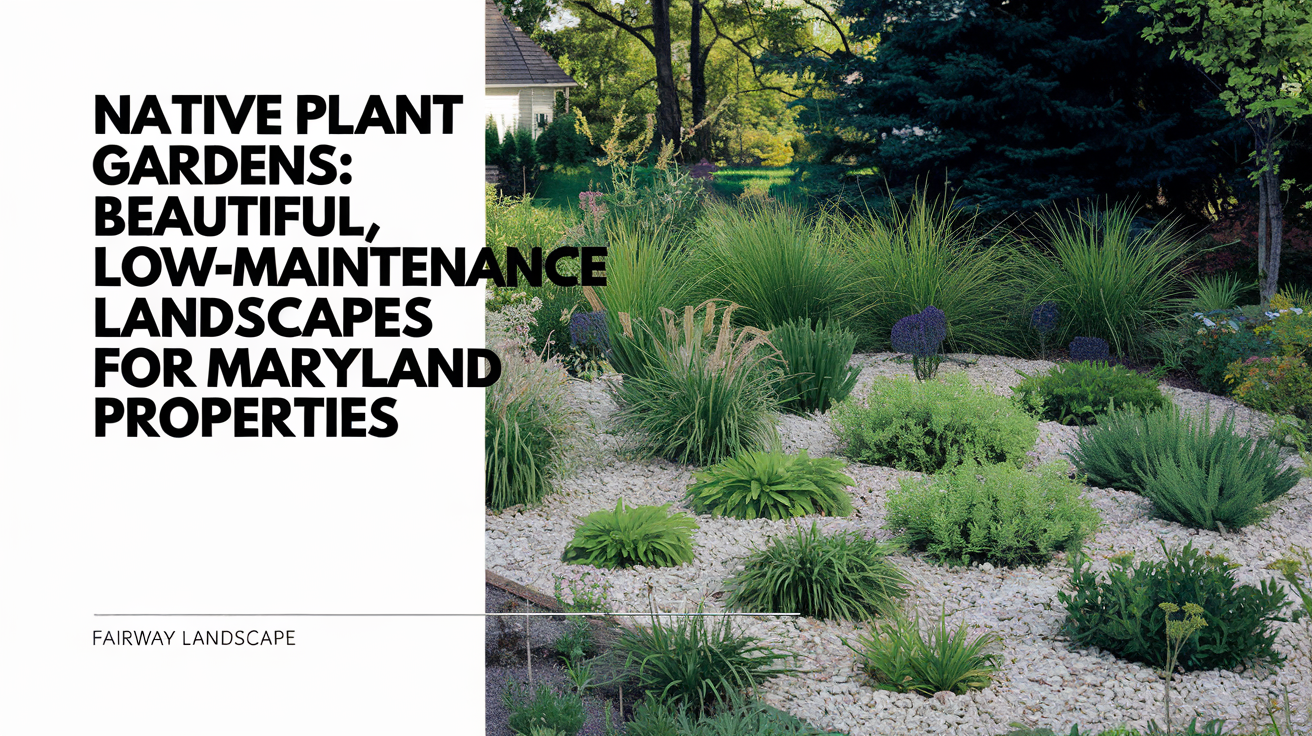The growing interest in sustainable, low-maintenance landscaping has brought native plant gardens from specialized ecological projects into mainstream landscape design. Homeowners throughout Maryland are discovering that native plants offer compelling advantages beyond their environmental benefits—from reduced maintenance requirements and lower water needs to distinctive beauty that connects landscapes to our region’s natural heritage. When thoughtfully designed and properly installed, native plant gardens create landscapes that thrive with minimal intervention while providing year-round interest and valuable ecological functions.

Understanding the Native Plant Advantage
Regional adaptation ensures reliable performance. Plants native to Maryland have evolved over thousands of years to thrive in our specific soil conditions, precipitation patterns, and temperature extremes. This natural adaptation creates landscapes that perform consistently year after year without the intensive care many non-native plants require. Our sustainable landscape design builds upon these natural adaptations rather than fighting them.
Maintenance reduction stems from appropriate plant placement. When native plants are positioned in conditions that match their natural habitat preferences, they require minimal supplemental water, fertilization, or pest control once established. Our low-maintenance landscaping approach places each native species in appropriate site conditions that allow it to thrive with minimal intervention.
Biodiversity support extends throughout the food web. Native plants host specialized relationships with insects, birds, and other wildlife that non-native plants cannot replicate. Our Maryland native plant gardens incorporate species that support these ecological relationships, creating landscapes that buzz with life and activity throughout the growing season.
Designing Native Gardens for Year-Round Appeal
Seasonal planning ensures continuous interest. Thoughtfully designed native gardens provide changing focal points throughout the year—from spring ephemerals and summer blooms to fall color and winter structure. Our comprehensive design approach creates this sequential interest that ensures your landscape remains engaging across all seasons.
Structural diversity creates visual depth and habitat value. Effective native gardens incorporate multiple layers—from groundcovers and perennials to shrubs and canopy trees. This vertical diversity creates visually rich landscapes while providing varied wildlife habitat. Our professional designs create this structural complexity that distinguishes sophisticated native gardens from simple plant collections.
Color and texture relationships establish visual coherence. Successful native gardens balance plant characteristics to create harmonious compositions rather than chaotic mixtures. Our design expertise includes thoughtful plant combinations that create these aesthetic relationships while maintaining ecological functionality.
Native Plants for Different Maryland Landscapes
Coastal plain species thrive in eastern Maryland properties. Areas near the Chesapeake Bay and Atlantic coastal regions benefit from plants adapted to sandy soils and maritime influences. Our regional expertise includes appropriate native selections for these conditions—from salt-tolerant shrubs like bayberry and beach plum to distinctive perennials like seaside goldenrod and butterfly weed.
Piedmont region plants suit central Maryland landscapes. Properties in Harford, Baltimore, and surrounding counties benefit from plants adapted to the Piedmont’s clay soils and transitional climate. Our native plant palette includes regional specialties like oak-leaf hydrangea, wild geranium, and bottlebrush grass that thrive in these specific conditions.
Mountain region natives excel in western Maryland properties. Higher elevation areas with cooler temperatures and different soil conditions require specialized plant selections. Our comprehensive knowledge includes appropriate choices for these conditions—from resilient trees like serviceberry and redbud to distinctive understory plants adapted to mountain conditions.
Creating Pollinator-Friendly Native Landscapes
Bloom sequence planning ensures continuous nectar sources. Different pollinator species emerge and require nutrition at different times throughout the growing season. Our native pollinator plants selections create continuous bloom sequences that support diverse pollinator populations from early spring through late fall.
Larval host plants support complete butterfly life cycles. While many gardens include nectar sources for adult butterflies, successful butterfly habitat also requires specific host plants for caterpillars. Our comprehensive pollinator gardens incorporate these essential host plants—from milkweed for monarchs to spicebush for swallowtails—that allow butterflies to complete their life cycles within your landscape.
Pesticide-free management protects beneficial insects. Even organic pesticides can harm pollinators and other beneficial insects that native gardens aim to support. Our sustainable maintenance approaches emphasize cultural practices and selective intervention that preserve these valuable insect populations while maintaining landscape appearance.
Native Alternatives to Common Landscape Plants
Lawn reduction creates opportunities for native plant communities. Traditional turf areas can be partially replaced with native meadow gardens, woodland understory plantings, or rain gardens that reduce maintenance while increasing ecological value. Our professional native garden installation includes appropriate site preparation and establishment methods for these turf alternatives.
Foundation planting natives replace conventional exotic shrubs. Areas around buildings traditionally planted with non-native foundation shrubs can be transformed with native alternatives that provide similar structure with added ecological benefits. Our design expertise includes appropriate native selections that maintain the architectural function of foundation plantings while supporting local ecosystems.
Specimen plant substitutions create distinctive focal points. Statement plants that draw attention in key landscape locations can be native species rather than exotic varieties. Our sustainable landscape design incorporates these native focal points—from majestic oak trees to distinctive American fringe tree—that create memorable landscape moments with regional significance.
Site Preparation for Successful Native Gardens
Invasive species management must precede installation. Many sites require removal of aggressive non-native plants that would otherwise outcompete newly installed natives. Our professional preparation includes appropriate removal methods—from manual extraction to targeted herbicide application—that create clean planting conditions without harming surrounding areas.
Soil assessment guides amendment strategies. While natives generally tolerate regional soil conditions, construction disturbance often creates challenging situations requiring correction. Our comprehensive site preparation includes soil testing and appropriate amendments that create favorable establishment conditions while maintaining the regional soil characteristics to which natives are adapted.
Proper planting techniques significantly impact establishment success. Even appropriate native selections fail without proper installation methods. Our professional native garden installation includes appropriate planting depth, root preparation, and initial care that ensures successful establishment and long-term performance.
Maintaining Native Plant Landscapes
Establishment phase requires specific attention. While mature native gardens require minimal maintenance, newly installed plants need appropriate care during their first 1-2 years. Our comprehensive installation services include detailed establishment guidelines and optional maintenance programs that ensure successful transition from installation to self-sufficiency.
Selective intervention preserves design intent. Even well-designed native gardens benefit from occasional maintenance that prevents aggressive species from dominating and maintains intended visual relationships. Our professional maintenance approach includes this thoughtful intervention that preserves both ecological function and aesthetic quality.
Seasonal management differs from conventional landscape care. Native gardens benefit from maintenance timed to plant life cycles rather than arbitrary calendar schedules. Our ecological maintenance programs include appropriate timing for activities like spring cutbacks, selective deadheading, and fall cleanup that support plant health and wildlife habitat.
Economic Benefits of Native Landscapes
Installation cost comparisons favor native approaches. While professional native gardens require similar initial investment to conventional landscapes, they typically include more perennial material and fewer annuals requiring yearly replacement. This plant selection strategy creates better long-term value despite comparable initial costs.
Maintenance cost reductions accumulate significantly over time. Native landscapes typically require 50-75% less maintenance time and resource input than conventional alternatives once established. These reduced requirements translate to substantial cost savings throughout the landscape’s lifetime, whether maintained by homeowners or professional services.
Property value enhancements stem from distinctive character. Thoughtfully designed native landscapes create distinctive properties that stand out in the real estate market. This differentiation often translates to increased property values and market appeal that complement the direct maintenance savings these landscapes provide.
Common Concerns About Native Plant Gardens
Aesthetic expectations can be fully satisfied with proper design. Many homeowners worry that native gardens look “wild” or unkempt, but professional design creates native landscapes with the same visual coherence and appeal as conventional alternatives. Our design approach emphasizes these aesthetic considerations while maintaining ecological functionality.
Neighborhood compatibility concerns can be addressed through design. Properties in conventional developments can incorporate native plants in ways that complement surrounding landscapes rather than creating jarring contrasts. Our contextual design approach considers these neighborhood relationships while still achieving sustainability goals.
Transition strategies allow gradual implementation. Converting existing landscapes to native plants can occur incrementally rather than requiring complete renovation. Our phased implementation plans create manageable transitions that spread investment over time while progressively increasing native plant presence and ecological value.
Partner with Fairway Landscape for Native Garden Excellence
At Fairway Landscape, we specialize in creating beautiful, functional native plant gardens throughout Maryland. Our professional approach combines ecological knowledge, design expertise, and installation craftsmanship to create landscapes that connect you to our region’s natural heritage while reducing maintenance requirements. From small native garden additions to complete landscape transformations, our services address your property’s specific needs with sustainable, attractive solutions.
Contact us today to schedule your native landscape consultation. Our experienced designers will evaluate your property’s potential and develop a customized plan for incorporating native plants in ways that enhance both beauty and functionality. Don’t settle for high-maintenance conventional landscapes—partner with Fairway Landscape for native gardens that thrive naturally in our Maryland climate.

